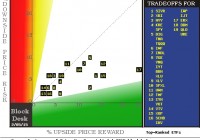Critiquing Klarman
Seth Klarman wrote a very good piece for the FT yesterday on the 12 things he’s learned from Warren Buffett. Only an idiot would disagree with Klarman so, like any good idiot, I wanted to write my own version/critique of Klarman’s thoughts: 1. Value investing works. Buy bargains. CR here – Yes, value investing works. I embrace value investing where appropriate . But it’s also tremendously difficult. As Buffett has stated on several occasions, you’re probably better off not trying to do what he does. You’re better off buying low fee index funds. More importantly, you should think of “investing” as your primary source of income. The thing most people call investing is actually a reallocation of savings. Treat it like savings and avoid the gambler mentality that leads so many astray. 2. Quality matters, in businesses and in people. Better quality businesses are more likely to grow and compound cash flow; low quality businesses often erode and even superior managers, who are difficult to identify, attract, and retain, may not be enough to save them. Always partner with highly capable managers whose interests are aligned with yours. CR here – Couldn’t agree more. As Buffett has stated, surround yourself with people who are smarter than yourself. If you’re me, just surround yourself with other people. 3. There is no need to overly diversify. Invest like you have a single, lifetime “punch card” with only 20 punches, so make each one count. Look broadly for opportunity, which can be found globally and in unexpected industries and structures. CR here – I think this is great advice in your personal life. I always talk about how real “investments” are made in our primary source of income. Don’t diversify there. Do one thing and do it well. Your savings, however, should be treated like savings. Diversify it broadly across many asset classes so it protects you from purchasing power loss and permanent loss, but don’t take so much risk here that it creates instability in your ability to plan for your financial future. 4. Consistency and patience are crucial. Most investors are their own worst enemies. Endurance enables compounding. CR here – Brilliant. You are own worst enemy. Educate yourself, create a process/plan and get out of the way. 5. Risk is not the same as volatility; risk results from overpaying or overestimating a company’s prospects. Prices fluctuate more than value; price volatility can drive opportunity. Sacrifice some upside as necessary to protect on the downside. CR here – Risk is the potential that we won’t meet our financial goals. Most of us don’t need to waste time looking at individual firms that have already been scoured by the smartest investment bankers and investment managers on Earth. If we beat inflation and do so without creating excessive permanent loss risk then we are beating most of the people engaged in the investment world. 6. Unprecedented events occur with some regularity, so be prepared. CR here – In other words, diversify so that you protect yourself not only from the unknown, but from your own stupidity. 7. You can make some investment mistakes and still thrive. CR here – you won’t just make some mistakes. You will make consistent mistakes. The goal is to engage in a strategy that exposes you to high probability of positive outcomes. Losses are part of the process. Learn from them and improve the odds of your future processes. 8. Holding cash in the absence of opportunity makes sense. CR here – as Buffett says, think of cash like a call option. A little bit of cash provides you with flexibility, permanent loss protection and the ability to contribute consistently to a broader plan. Your savings portfolio needs to be fed. Feed it consistently so it gets nice and fat. 9. Favour substance over form. It doesn’t matter if an investment is public or private, fractional or full ownership, or in debt, preferred shares, or common equity. CR here – think macro, not micro. Different asset classes are a function of differing legal structures and behaviors. When pieced together correctly they should complement one another even if they don’t always agree with one another. 10. Candour is essential. It’s important to acknowledge mistakes, act decisively, and learn from them. Good writing clarifies your own thinking and that of your fellow shareholders. CR here – in other words, write a financial site where you critique people who are much smarter than you are. 11. To the extent possible, find and retain like-minded shareholders (and for investment managers, investors) to liberate yourself from short-term performance pressures. CR here – if your investment manager doesn’t eat his own cooking then maybe they shouldn’t be cooking for you. 12. Do what you love, and you’ll never work a day in your life. CR here – don’t do what you love. Do something other people will love you for doing. Good capitalists serve themselves best by serving others.

